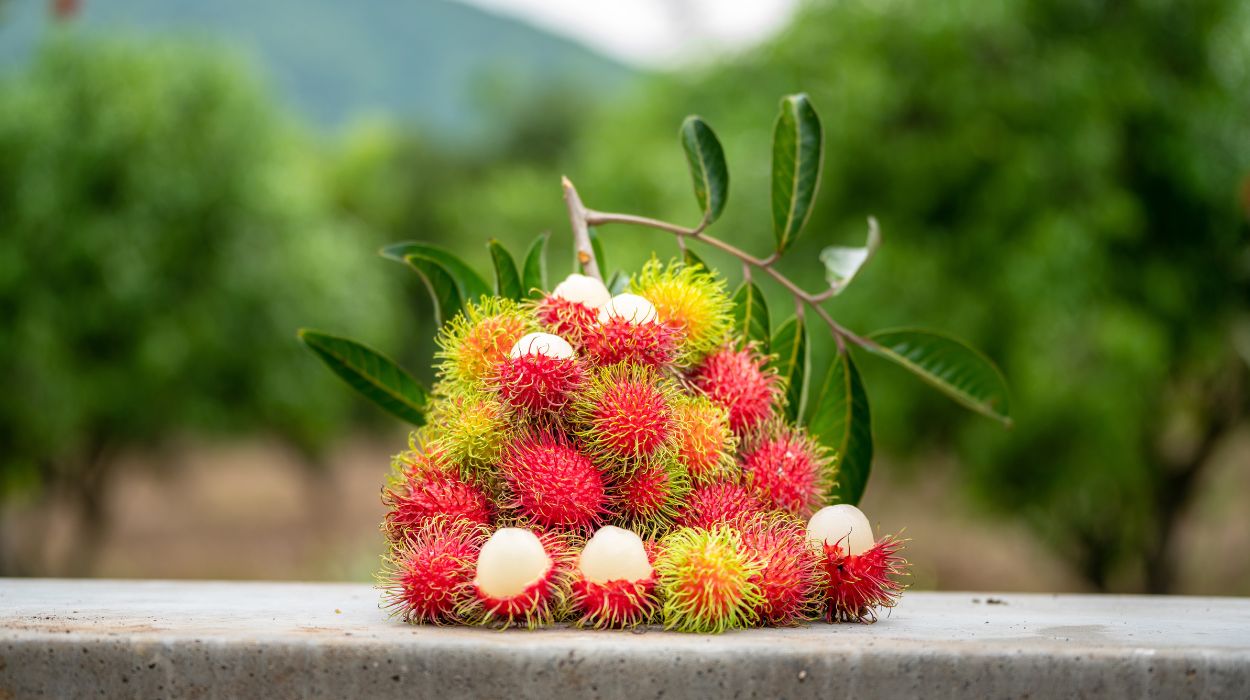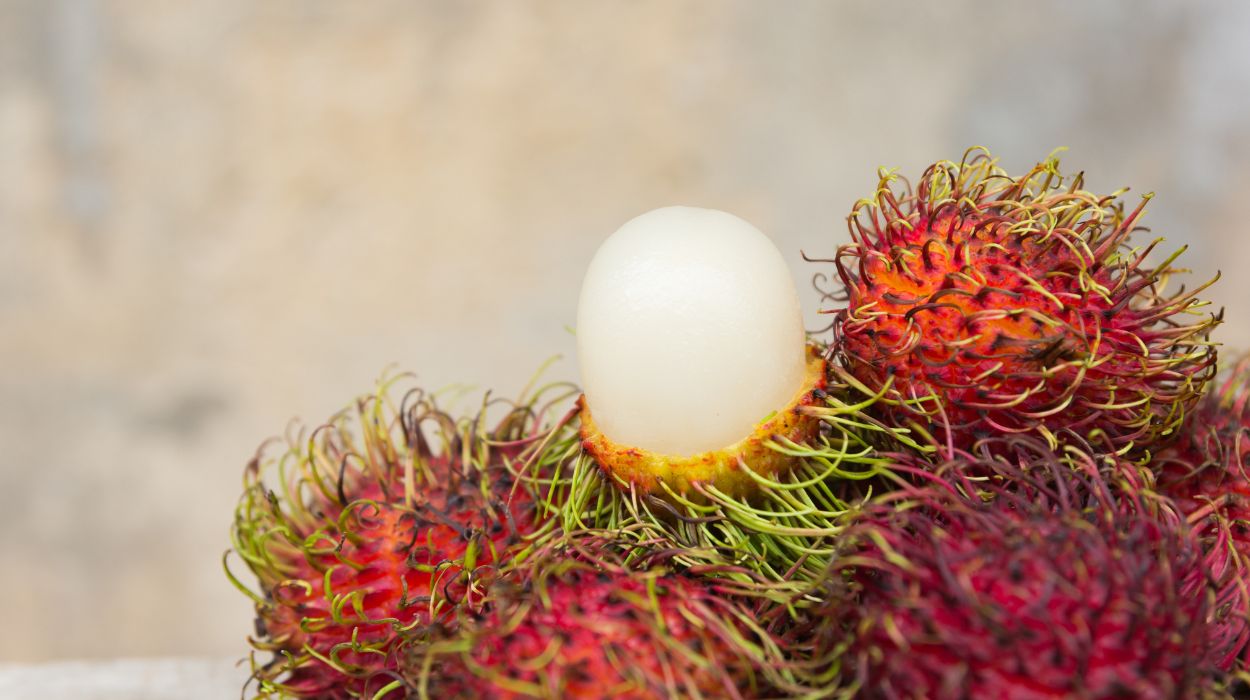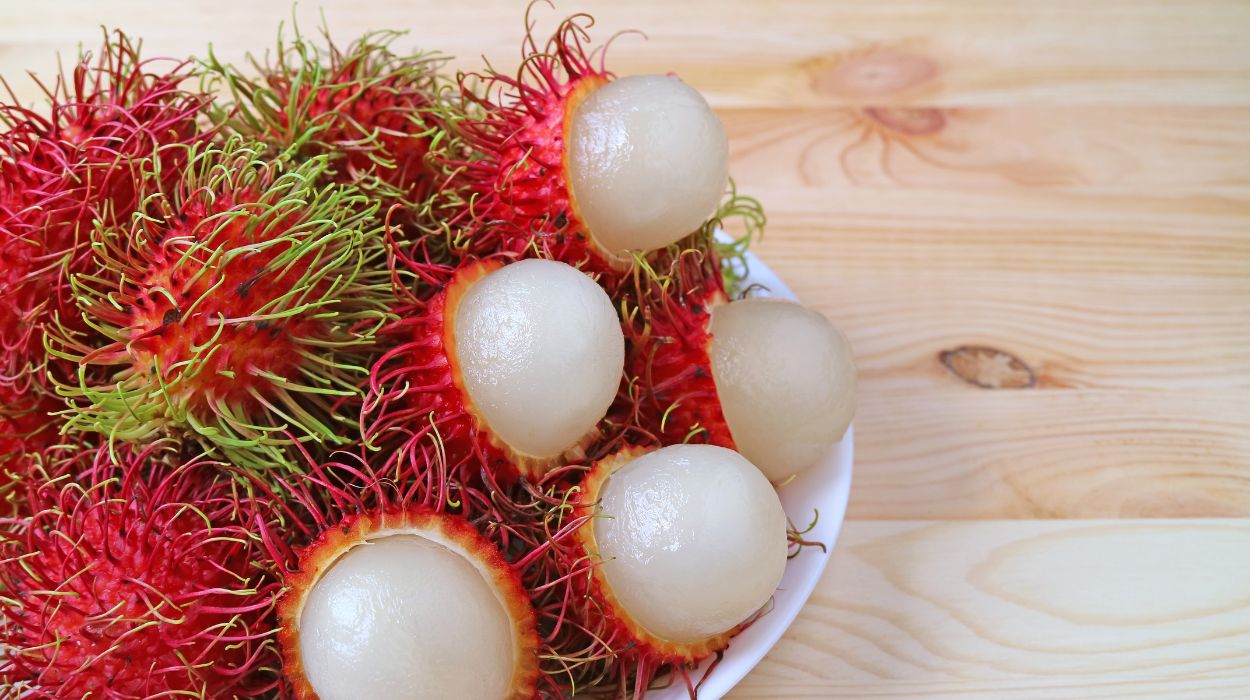 Evidence Based
Evidence Based
Evidence Based
This article is objectively based on relevant scientific literature, written by experienced medical writers, and fact-checked by a team of degreed medical experts.
Our team of registered dietitian nutritionists and licensed medical professionals seek to remain objective and unbiased while preserving the integrity of any scientific debate.
The articles contain evidence-based references from approved scientific sites. The numbers* in parentheses (*1,2,3) will take you to clickable links to our reputable sources.
Rambutan Benefits: Nutrition & Risks Of This Tasty Fruit 2024

Rambutan is a strange-looking fruit that resembles something you might find down Alice’s rabbit hole in Wonderland. However, it is an actual fruit you find commonly throughout Southeast Asia. They are also becoming quite popular in the United States because of their fantastic health benefits. January is the prime season for rambutan.
The fruit is about the size of a golf ball and has a green outside with red-type hairs growing all over its shell. The fruit is closely related to the lychee and longan fruits and has a similar look once peeled. Most people describe the taste as tart, creamy, and sweet. It also contains a seed in the middle of the flesh.
Some of the health benefits of rambutan include digestive health and weight loss. To learn more about these and other rambutan fruit benefits, read below.
7 Rambutan Fruit Benefits
Rambutan fruit offers various health benefits including:
- Prevent cancer
- Boost immune system
- Improve digestive health
- Provide copper
- Aid weight loss
- Improve heart health
- Prevent kidney stones
Rambutan Benefits

Eating rambutan is a treat for your tastebuds and your entire body. Rambutan has benefits like preventing cancer, boosting immune function, aiding digestion, and promoting weight loss. To learn more about these rambutan health benefits in detail, continue reading.
Prevent Cancer
Currently, no human studies prove rambutan has anti-cancer effects. However, the antioxidants found in rambutan have long been associated with cancer prevention. Antioxidants are essential because they combat free radicals.
Free radicals are unstable molecules in the body. If free radicals become too abundant, they can cause conditions such as heart disease, diabetes, and the development of cancer cells. Of note, choosing fresh rambutan will provide the highest amount of antioxidants.
The antioxidants found in rambutan include:
- Anthocyanins
- Methanolic compounds
- Phenolic compounds
- Vitamin C
Vitamin[1] C has been linked to a decreased[2] risk of several types of cancer (including lung, breast, and prostate).
A systematic review[3] from 2019 showed that a diet rich in anthocyanins decreased the cell growth, differentiation, and inflammation response of colorectal cancer.
Methanolic and phenolic compounds are great antioxidants for cancer prevention and are also being studied[4] for potential cancer treatment in the future. This would provide an excellent treatment for cancer without the adverse side effects of pharmaceuticals or chemotherapy.
Non-human studies[5] have shown that the rambutan seeds hold a trypsin inhibitor with anti-cancer effects.
Boost Immune System
Rambutan[6] contains about 50% of your daily needs of vitamin C (per 5 rambutan fruits). Vitamin C[7] is vital to your immune system as it:
- Encourages the body to create more white blood cells, which helps fight against infections.
- Protects white blood cells from getting hurt by free radicals.
- Decreases inflammation in the human body because it is a powerful antioxidant.
Vitamin C also helps keep skin healthy and promotes wound healing. This is because it helps to ward off germs attempting to get into your body through the skin. In addition, studies have shown that people with higher levels of vitamin C[8] tend to have better health outcomes when hospitalized than those with lower levels.
Therefore, if you are concerned you have a weak immune system, rambutan may be an excellent choice to add daily vitamin C to your diet.
Improve Digestive Health
Just one rambutan provides almost 10% of your daily fiber needs. Fiber is essential for the well-being of your gut microbiome. Your microbiome is a term used to define the ecosystem of the different bacteria in your digestive tract.
A well-balanced microbiome[9] is essential for:
- Proper absorption of nutrients
- A well-functioning immune system
- Mood regulation
- Much more
Further, all body functions are thought to be centered around the microbiome. Therefore, maintaining a healthy gut microbiome is crucial to your health. To ensure your microbiome is in excellent health, it is vital to have a well-balanced variety of good and bad bacteria within the intestines.
The good bacteria in our digestive system use fiber for food. Therefore, healthy gut bacteria will starve if you do not consume enough fiber. If the good bacteria are starved, they will die off, upsetting the delicate balance of your microbiome.
Unfortunately, a study[10] performed in 2017 revealed only one in 20 American’s consume enough fiber. Consuming foods high in fiber, such as rambutans, can help you close that gap.
In addition to providing food for your good gut bacteria, soluble fiber also produces short-chain fatty acids. These short-chain fatty acids[11] can decrease inflammation, help regulate appetite and improve chronic digestive issues like irritable bowel syndrome (IBS), ulcerative colitis, and Crohn’s disease.
Provide Copper
Eating four rambutans will provide you with around 20% of your daily copper[12] needs. Copper is an essential trace mineral, so your body cannot make enough of it to survive. Instead, you must obtain most of it through food consumption. Copper is important for several functions within the body, such as
- Assisting enzymes to produce energy for the body
- Breaking down and absorbing iron
- Creating red blood cells
- Producing collagen production
- Constructing new connective tissue
- Building neurotransmitters
- Supporting brain development
- Sustaining immune function
Even though deficiencies are rare in the United States, they can occur. Signs of copper deficiency include anemia, high blood cholesterol, osteoporosis, and loss of skin pigment.
Aid Weight Loss
Similar to most fruits, rambutans can help with weight loss.[13] Fruits are one of our biggest allies when it comes to fighting weight gain, and that is because they are low in calories and high in water and fiber content. High fiber and low calories are a great combination for weight loss as it keeps you feeling satiated even though you have ingested only a few calories.
Additionally, rambutans contain soluble fiber,[13] which forms a glue-type substance in your bowels. This substance helps to slow your digestion and thus leads to a reduced appetite and a greater feeling of satiation. Getting 14 grams of fiber[14] per 1,000 calories is recommended to maintain overall health.
Lastly, rambutans are approximately 80% water. This helps to also fill up your stomach with water which has no calories. Plus, water[15] is excellent for:
- Improving mood
- Enhancing cognition
- Improving sleep quality
- Delivering nutrients
- Preventing infections
- Keeping joints lubricated
- Regulating body temperature
In addition, rambutans have a delightful taste due to their natural sugars. This can help you curb cravings for sweets, making rambutans a good choice for you as a treat that will prevent weight gain.
Improve Heart Health
As stated previously, rambutan is high in vitamin C. Vitamin C helps to fight against free radicals that can damage arteries and vessels if they become too abundant in the body.
Rambutans also contain potassium which is a long-time beneficial nutrient for the heart. Potassium helps to maintain a regular heartbeat by aiding in the control of electrical signals of the middle layer of your heart muscle. Potassium can also help lower blood pressure as it relaxes the vessel walls. A diet that is adequate in potassium reduces[16] your risk of stroke and cardiovascular disease.
Lastly, the folate found in rambutans helps lower homocysteine levels which cause inflammation. Sources say that diets high in folate can reduce your risk of stroke[17] by 25%.
Prevent Kidney Stones
The most common form of kidney stones are the stones that come from calcium oxalate. Increasing potassium consumption encourages your kidneys to reabsorb calcium, thus making your urine less acidic.
Of note, rambutans are not extremely high in potassium; therefore, you should pair rambutans with other high-potassium foods such as potatoes, beans, lentils, or bananas to achieve your desired effects.
Interestingly, the juicy flesh is not the only part of the rambutan fruit with health benefits. The leaves and bark of rambutans have been used for thousands of years to prevent headaches and treat oral thrush.
Nutritional Profile Of Rambutan

Per 100 grams of fresh rambutan fruit:
- Calories 75
- Carbohydrates 16 grams
- Protein 0.6 grams
- Copper 0.1 milligrams
- Vitamin c 65 milligrams
- Folate 7.3 micrograms
- Fiber[18]: 2 grams
Side Effects Of Rambutan
Rambutan has many health benefits but also some side effects. Be aware that some healthy adults may be allergic to rambutan. If you have any of these symptoms while or after consuming rambutan, discontinue eating it immediately and contact your doctor.
- Hives
- Itching
- Swelling
- Rashes
Another thing to remember is that canned rambutan can be very high in sugar content. Therefore, try to only purchase fresh or canned with no sugar added. You can also pair it with other healthy fruits and vegetables to prevent overeating.
Lastly, be mindful that the seeds (in any form) are not recommended for consumption. They have been shown[19] to mimic narcotics and may also contain a toxic compound called saponins. Therefore, take the seed out of the flesh before consuming the fruit.
Ways To Consume Rambutan
Rambutan fruit, with its sweet and juicy flesh, can contribute to a healthy and well-balanced diet when consumed in moderation. However, you should consider a few things to incorporate into your daily life.
Rambutan can be found in the grocery store’s exotic or tropical fruits section or in Asian markets. You can purchase it fresh or canned. In some stores, you can buy rambutan juice or jams as well. If you are consuming fresh rambutan, choose a deep red fruit. A ripe rambutan tastes entirely different from an unripe fruit. The darker the color, the more ripe the fruit.
Next, you will remove the rambutan peel or skin by slicing the outer skin with a sharp knife. You can then scoop the fruit with a spoon or squeeze the sides, and the fruit should pop out. Once you have the fruit free of the skin, you will notice the large seed in the middle. Again, it would be best if you did not eat the seed. Hence, remove it before ingesting the flesh.
Once you have the flesh, it can be eaten raw for a delicious snack, added to fruit salad, smoothies, ice creams, or even in puddings to add exotic flavor. Some health food stores even carry rambutan sorbet which is a delicious treat. With its low rambutan calories content and rich taste, it’s a guilt-free indulgence for any dessert lover.
The Bottom Line
In summary, rambutan is an exotic fruit found in most health food stores and Asian markets. It has a whimsical hairy dark red outside and a very creamy yet sweet taste inside. The seed, however, should not be eaten as it could be toxic.
This fruit is low in calories yet high in fiber, vitamins, minerals, and potent antioxidants. These nutrients have impressive health benefits, such as aiding weight loss, helping digestion, enhancing immune function, and potentially preventing cancer.
The fruit’s flesh can easily be eaten raw as a snack or added to several dishes such as fruit salads, yogurts, puddings, and smoothies for an exotic flavor. Try adding them to your healthy eating regimen today.
+ 19 sources
Health Canal avoids using tertiary references. We have strict sourcing guidelines and rely on peer-reviewed studies, academic researches from medical associations and institutions. To ensure the accuracy of articles in Health Canal, you can read more about the editorial process here
- Yu, N., Su, X., Wang, Z., Dai, B. and Kang, J. (2015). Association of Dietary Vitamin A and β-Carotene Intake with the Risk of Lung Cancer: A Meta-Analysis of 19 Publications. Nutrients, [online] 7(11), pp.9309–9324. doi:10.3390/nu7115463.
- Vissers, M.C.M. and Das, A.B. (2018). Potential Mechanisms of Action for Vitamin C in Cancer: Reviewing the Evidence. Frontiers in Physiology, [online] 9. doi:10.3389/fphys.2018.00809.
- Medic, N., Tramer, F. and Passamonti, S. (2019). Anthocyanins in Colorectal Cancer Prevention. A Systematic Review of the Literature in Search of Molecular Oncotargets. Frontiers in Pharmacology, [online] 10. doi:10.3389/fphar.2019.00675.
- Abotaleb, M., Liskova, A., Kubatka, P. and Büsselberg, D. (2020). Therapeutic Potential of Plant Phenolic Acids in the Treatment of Cancer. Biomolecules, [online] 10(2), p.221. doi:10.3390/biom10020221.
- Fang, E.F. and Ng, T.B. (2015). A Trypsin Inhibitor from Rambutan Seeds with Antitumor, Anti-HIV-1 Reverse Transcriptase, and Nitric Oxide-Inducing Properties. Applied Biochemistry and Biotechnology, [online] 175(8), pp.3828–3839. doi:10.1007/s12010-015-1550-1.
- Arenas, M.G.H., Angel, D.N., Damian, M.T.M., Ortiz, D.T., Díaz, C.N. and Martinez, N.B. (2011). Characterization of rambutan (Nephelium lappaceum) fruits from outstanding mexican selections. Revista Brasileira de Fruticultura, [online] 32(4), pp.1098–1104. doi:10.1590/s0100-29452011005000004.
- Nih.gov. (2020). Office of Dietary Supplements – Vitamin C. [online] Available at: https://ods.od.nih.gov/factsheets/VitaminC-HealthProfessional/.
- Lykkesfeldt, J. (2020). On the effect of vitamin C intake on human health: How to (mis)interprete the clinical evidence. Redox Biology, [online] 34, p.101532. doi:10.1016/j.redox.2020.101532.
- Cronin, P., Joyce, S.A., O’Toole, P.W. and O’Connor, E.M. (2021). Dietary Fibre Modulates the Gut Microbiota. Nutrients, [online] 13(5), p.1655. doi:10.3390/nu13051655.
- Quagliani, D. and Felt-Gunderson, P. (2016). Closing America’s Fiber Intake Gap. American Journal of Lifestyle Medicine, [online] 11(1), pp.80–85. doi:10.1177/1559827615588079.
- Prasad, K.N. and Bondy, S.C. (2018). WITHDRAWN: Dietary fibers and their fermented short-chain fatty acids in prevention of human diseases. Mechanisms of Ageing and Development. [online] doi:10.1016/j.mad.2018.10.003.
- The Nutrition Source. (2022). Copper. [online] Available at: https://www.hsph.harvard.edu/nutritionsource/copper/.
- Schroder, K.E.E. (2010). Effects of fruit consumption on body mass index and weight loss in a sample of overweight and obese dieters enrolled in a weight-loss intervention trial. Nutrition, [online] 26(7-8), pp.727–734. doi:10.1016/j.nut.2009.08.009.
- Usda.gov. (2022). AskUSDA. [online] Available at: https://ask.usda.gov/s/article/How-much-dietary-fiber-should-I-eat.
- News. (2017). The importance of hydration. [online] Available at: https://www.hsph.harvard.edu/news/hsph-in-the-news/the-importance-of-hydration/.
- Weaver, C.M. (2013). Potassium and Health. Advances in Nutrition, [online] 4(3), pp.368S377S. doi:10.3945/an.112.003533.
- Nih.gov. (2016). Office of Dietary Supplements – Folate. [online] Available at: https://ods.od.nih.gov/factsheets/Folate-HealthProfessional/.
- Gorinstein, S., Zemser, M., Haruenkit, R., Chuthakorn, R., Grauer, F., Martin-Belloso, O. and Trakhtenberg, S. (1999). Comparative content of total polyphenols and dietary fiber in tropical fruits and persimmon. The Journal of Nutritional Biochemistry, [online] 10(6), pp.367–371. doi:10.1016/s0955-2863(99)00017-0.
- Jirawat Eiamwat, S. Reungpatthanaphong, S. Laovitthayanggoon and B. Tiensong (2014). Toxicity studies on rambutan (Nephelium lappaceum) seed fat and oil extracts using acute oral, dermal and… [online] ResearchGate. Available at: https://www.researchgate.net/publication/307877777_Toxicity_studies_on_rambutan_Nephelium_lappaceum_seed_fat_and_oil_extracts_using_acute_oral_dermal_and_irritation_assays.



